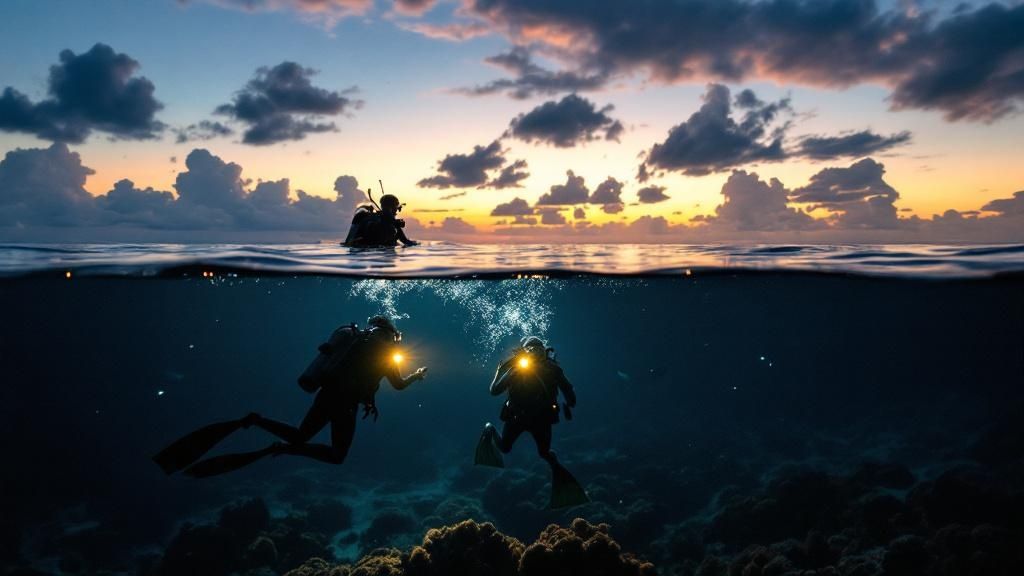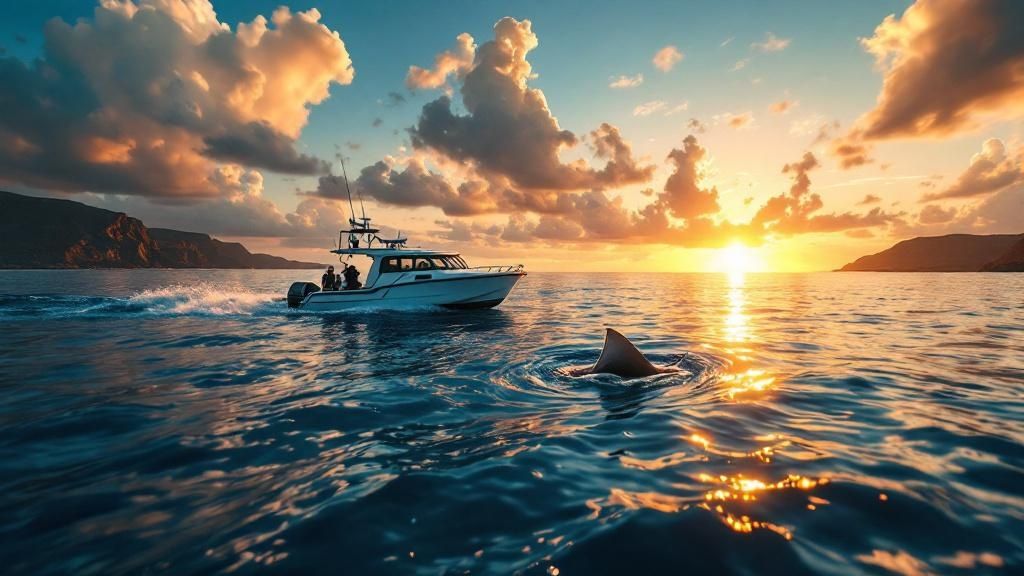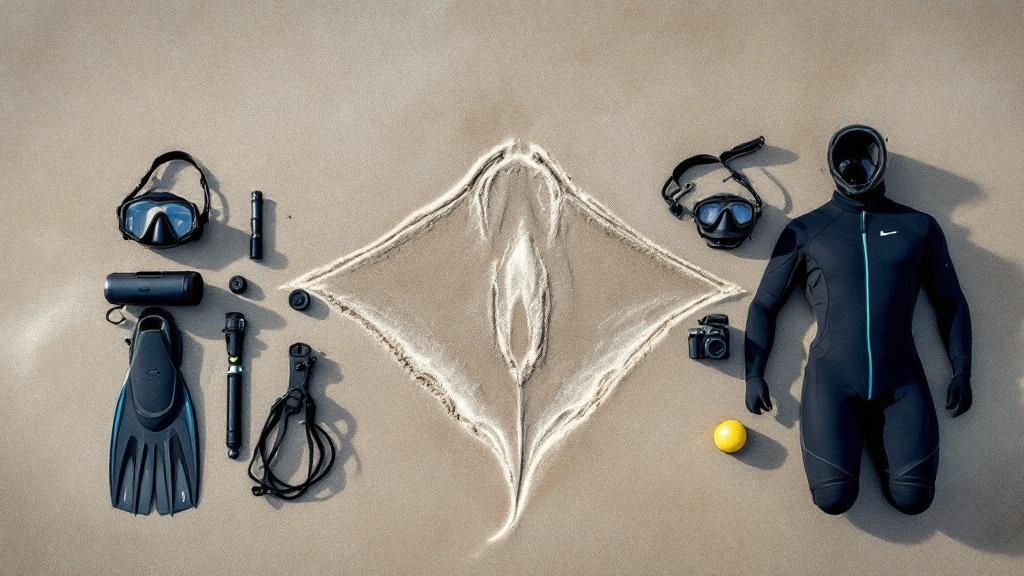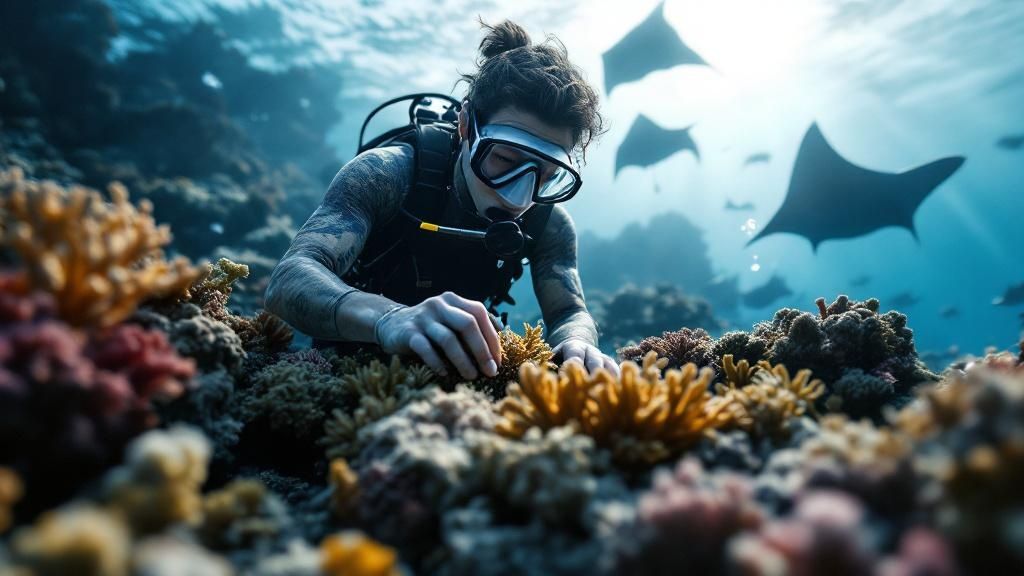Picture this: you’re descending into the warm, dark Pacific just as the sun dips below the horizon. The world goes quiet. Then, out of the deep blue, a graceful giant emerges, gliding effortlessly through the beams of underwater lights. This is the manta ray dive in Kona, an incredible, almost surreal ballet that has put Hawaii's Big Island on the map for divers worldwide.

Why Kona is the World's Manta Ray Capital
The Kona coast is more than just another pretty Hawaiian shoreline; it's a world-renowned hotspot for seeing manta rays reliably, year-round. It all comes down to the unique underwater topography created by ancient lava flows. These volcanic formations create natural shelters and cleaning stations for the mantas.
Even more importantly, the local currents funnel plankton—their main food source—into very specific, predictable areas. This natural phenomenon is what makes Kona so special. In fact, it's so popular that around 80,000 people come to snorkel and dive with the mantas off the Kona Coast every single year, making it one of the most famous wildlife encounters on the planet.
The Science Behind the Spectacle
So, what's the secret sauce that makes the Kona manta ray experience so consistent night after night? It’s a brilliantly simple strategy: light.
- Attracting the Food: Dive operators head to known manta feeding grounds and set up powerful, submerged lights on the ocean floor.
- Creating a Plankton Buffet: These bright lights attract massive clouds of plankton, drawing them up from the darker depths into a concentrated feast.
- The Main Event: The mantas, being filter feeders, show up for the easy meal. They perform mesmerizing, acrobatic loops and barrel rolls to scoop up the dense plankton.
It's like a nightly "campfire" on the seafloor that acts as a dinner bell for the mantas. This method is a fantastic, non-invasive way to bring humans and wildlife together for a truly breathtaking show.
This guide is designed to give you the real-world advice you won't find in a glossy brochure. We'll walk you through everything from picking the right tour to what to expect once you're in the water. For an even deeper dive, check out our article on the manta ray night dive in Kailua Kona. Our goal is to make sure you feel completely prepared for what might just be the adventure of a lifetime.
Choosing the Right Manta Ray Tour for You

Okay, let's talk about one of the most important parts of your whole trip: picking the right manta tour. This decision genuinely shapes your entire experience. It's the difference between a good night and an absolutely unforgettable, once-in-a-lifetime encounter.
The first big choice you’ll make is how you want to see the mantas: from the surface by snorkeling, or from below by scuba diving. Your comfort in the water and any certifications you have will make this decision for you.
Snorkel vs. Scuba: Two Ways to See the Show
Snorkeling is fantastic because almost anyone can do it. You don't need any prior experience, just a sense of adventure. You'll float on the surface, usually holding onto a custom light board that shines a bright beam into the dark water. This light attracts the plankton, which in turn brings the giant, gentle mantas right up to you. It's an amazing option, especially for families or anyone who isn't a certified diver.
Scuba diving, on the other hand, puts you right in the middle of the action. If you're a certified diver, this is the way to go. You'll descend to a shallow, sandy bottom—usually only about 30 to 40 feet deep—and kneel with your group. The dive lights create a "campfire" effect, and you get to look up as these magnificent creatures perform a silent ballet just inches above your head. It’s an immersive, jaw-dropping perspective you can’t get any other way.
Kona’s World-Famous Manta Dive Sites
Once you’ve settled on snorkeling or diving, you'll want to know about the location. Kona is home to two primary, world-renowned sites for manta encounters. Most tour operators will pick the site based on daily conditions and where the mantas have been most active, but it’s good to know the lay of the land.
To help you understand the differences, here's a quick comparison of Kona's two main manta ray dive sites. This can help you know what to expect, regardless of where your operator decides to go that night.
Kona Manta Ray Dive Site Comparison
| Feature | Manta Village (Keauhou Bay) | Manta Heaven (Near Airport) |
|---|---|---|
| Location | South of Kailua-Kona | North of Kona, near the airport |
| Boat Ride | Shorter, from Keauhou Harbor | Longer, from Honokohau Harbor |
| Conditions | Generally calmer, more protected | Can sometimes be a bit choppier |
| Reliability | Extremely consistent sightings | Also very high, often more mantas |
| Best For | Divers prone to seasickness, beginners | Divers seeking the most action |
Ultimately, you can't go wrong with either spot. Both offer incredible, world-class viewing opportunities. Researchers have found that Kona averages around 20 manta sightings per night dive, which is double what other top global destinations report! Combine that with water visibility that often hits 100 feet, and you have the perfect recipe for an amazing night.
Finding a Reputable and Responsible Operator
This part is crucial: not all tour operators are the same. A great company doesn't just shuttle you out to the water. They provide knowledgeable guides, maintain strict safety standards, and show a genuine commitment to protecting these animals.
When you're looking at different companies, don't be afraid to ask questions. A reputable operator will be more than happy to talk about their safety procedures, guide experience, and conservation efforts.
For a little more inspiration, check out our guide on why you should go on a manta ray dive in Kona. It really brings to life why this is such a bucket-list adventure. Booking with confidence means finding a team that cares as much about your safety as they do about the well-being of Kona's beloved manta rays.
A Step-by-Step Walkthrough of Your Dive Night
The buzz of anticipation for your manta ray dive in Kona really kicks in the moment you arrive at the harbor. As the Hawaiian sun dips toward the horizon, the air is electric with excitement. This is where your adventure truly starts—not in the water just yet, but with the all-important pre-dive briefing.
Your divemasters and the boat crew will bring everyone together for a detailed safety talk. Don't tune this part out; it's absolutely crucial. You'll learn the golden rules of "passive interaction," which are designed to keep the mantas safe. The big one? Never, ever touch them, and always stay on the sandy bottom.
They'll also walk you through the plan for the night, explain how the gear works, and share some incredible facts about Kona’s resident manta population. I've always found that this briefing does more than just inform—it turns a boatload of strangers into a cohesive team, ready for a respectful and amazing encounter.
The Sunset Voyage
With the briefing done, it's time to board the boat and head out to the site. This short trip during the golden hour is a magical experience in itself. The Kona coastline, with its stark black lava rock set against a fiery sunset, is something you won't soon forget.
Once the boat is anchored, the crew springs into action to set up what everyone lovingly calls the underwater "campfire." This involves placing a circle of powerful, upward-facing lights on the ocean floor, usually at a depth of about 30-40 feet.
The whole idea is beautifully simple. The intense light attracts swarms of plankton—the mantas' favorite meal—creating an irresistible buffet that draws these gentle giants in for their nightly feast. It’s like ringing the dinner bell.
As the last glow of sunlight disappears, it's time to gear up. You'll run through your final checks with your buddy, and with one giant stride, you’ll plunge into the warm, dark Pacific. This is it. The real adventure is about to begin.
The Underwater Ballet
Descending into the dark is a sensation unlike any other. Your entire world narrows to the beam of your dive light as you follow your guide down to the sandy bottom. Your group will find a spot in a semi-circle around the central lights, get settled on your knees, and aim your own dive lights straight up to add to the glow.
And then, you wait.
Honestly, it's rarely a long wait. First, you might catch a glimpse of a single ghostly shape gliding out of the blackness. Then another appears. Before you know it, several giant manta rays are swooping, soaring, and doing barrel rolls just inches over your head. It's completely silent and graceful, an utterly mesmerizing ballet. The only thing you'll hear is the steady rhythm of your own breathing.
This level of consistency is no fluke. In-depth manta ray sighting statistics, painstakingly collected by divers and researchers between 2009 and 2014, helped map out the behavior of individual mantas six to seven nights a week. This research gave us a profound understanding of their movements and feeding habits, which is what makes the Kona manta ray dive one of the most reliable big-animal encounters on the planet. You can dive deeper and explore the research on manta sighting consistency for yourself.
After what feels like both an eternity and the blink of an eye, your guide will give the signal to ascend. You’ll head back to the surface with a memory that, I promise, will stay with you forever.
Gearing Up and Getting the Perfect Shot

A little bit of prep work goes a long way in making your manta ray dive in Kona truly unforgettable. You want to be focused on the mantas, not shivering or fumbling with gear. Your dive operator will supply the big stuff—tanks, weights, and the powerful lights for the "campfire"—but a few personal items are non-negotiable for your comfort.
Most quality operators will provide a nice, thick wetsuit, usually a 5mm or even a 7mm, because you'll be staying still on the sandy bottom for a while. What they don't provide is what you'll need the second you surface. Trust me on this: pack a big, fluffy towel and a warm, dry change of clothes. That boat ride back to the harbor can get chilly.
And a quick word to the wise: if you have even the slightest tendency toward motion sickness, take something for it before you even step on the boat. A rocking boat at night can be a tough combination, and you don’t want that to ruin the main event.
Capturing the Manta Magic on Camera
Photographing the manta night dive is one of the most incredible challenges you can have as an underwater photographer. It’s dark, the subjects are moving, and the typical rules don't always apply. First things first, leave your powerful strobes at home. They can be disruptive to the mantas and often create harsh hot spots and backscatter in these conditions.
The real key is a good, wide-beam continuous video light. It provides a steady source of illumination that lets your camera’s autofocus do its job in the dark. More importantly, it lights up the scene without the startling flash, allowing you to capture the buttery-smooth motion of the mantas as they swoop and glide.
Pro Tip: The goal isn't just to get a picture of a manta ray; it's to capture their incredible grace. Think less about a single "snapshot" and more about capturing their fluid, ballet-like dance in the light. This is where smooth video or high-frame-rate shooting really shines.
Get your camera settings sorted out before you even hit the water. I recommend starting with a wide-open aperture (the lowest f-number your lens allows) to maximize light intake and bumping up your ISO. From there, you can play with your shutter speed to find that sweet spot between freezing the action and avoiding motion blur. For a deep dive into cameras and more, check out our complete guide on the gear you will need for your Kona diving adventure.
GoPro Pointers and Remembering to Look Up
Bringing a GoPro? Great choice. They’re compact and do a fantastic job of capturing the sheer scale of the experience. The wide-angle lens is perfect for showing just how massive these mantas are as they pass inches from your head. My advice is to just hit record and let it run; it's much easier than trying to snap individual photos in the dark.
A few quick tips to get the best GoPro footage:
- Get a tray and handle. This is the single best way to get stable, watchable video.
- Ditch the red filter. Those are for daytime dives to bring back color. At night, they just block precious light.
- Pack extra batteries. Cold water and constant video recording will drain your battery faster than you think.
Finally, and this might be the most important tip of all: don't get so lost behind the lens that you miss the show. There comes a point where you should just put the camera down, relax, and watch. Be present for one of the most awe-inspiring spectacles nature has to offer. You won’t regret it.
Practicing Responsible Manta Ray Tourism

Getting in the water with Kona's manta rays is more than just another dive; it’s a privilege. We are stepping into their world, and that comes with a serious responsibility to protect the resident manta population that makes Kona so special. It’s on us to ensure these magnificent creatures are here for future generations to marvel at.
The whole encounter is built around one simple "Golden Rule": passive interaction. This isn't just a friendly tip—it's the core principle that every reputable operator lives by to keep the mantas safe and healthy. You’re there to be a respectful guest at their nightly feast.
At its heart, passive interaction means you never, ever touch, chase, or cut off a manta ray. Their skin is covered in a delicate mucus layer, which is their primary defense against nasty bacteria. When you touch a manta, you can strip that protective coating away, leaving them open to infections.
The Manta Interaction Code of Conduct
To make your dive both unforgettable for you and completely safe for the mantas, everyone in the water needs to follow a few straightforward rules. Your divemaster will hammer these home in the briefing, but knowing them ahead of time helps you get into the right frame of mind.
- Observe, Don't Interact: The urge to reach out can be strong, but you have to resist. Let the mantas dictate the encounter. If they want to get close, they will.
- Hold Your Position: As a diver, your place is on or very near the sandy bottom. If you're snorkeling, you stay on the surface. This keeps the water column wide open, giving the mantas a clear and safe "runway" to swoop and glide through.
- Lights Up: Divers should point their flashlights straight up toward the surface. This technique concentrates the plankton above you and, just as importantly, keeps the bright beams out of the mantas' eyes as they glide overhead.
Sticking to these rules is everything. The Kona dive community has put a ton of effort into building a sustainable model for this incredible wildlife experience, and its success hinges on every single person in the water doing their part.
By simply being a quiet, passive observer, you are playing a direct role in the conservation and health of one of the planet's most spectacular natural encounters. Your respect is what makes it all possible.
The discussion around how to best protect these animals is always evolving. If you're curious about the specifics of the official regulations, you can get a deeper understanding by reading this open letter to the Hawaii DLNR regarding manta rules. It underscores just how critical standardized, responsible practices are. Your very first step in being a good manta steward is choosing an operator who puts the ocean first.
Answering Your Manta Ray Dive Questions
It’s completely normal to have a few last-minute questions, even with the best-laid plans. It’s a new adventure, after all! To help you feel fully prepared and confident, we’ve put together answers to the questions we hear most often from divers and snorkelers getting ready for their big night.
Let's dive right in.
Is the Manta Ray Dive Safe for Beginners?
Absolutely. I get this question all the time, especially from people who are new to diving or haven't done a night dive before. The Kona manta ray dive is one of the most beginner-friendly ocean experiences you can find.
For divers, the whole operation is in calm, shallow water, usually just 30-40 feet deep. You’ll spend your time kneeling or sitting on the sandy bottom, watching the show above. There's no complex navigation or tricky buoyancy required, making it incredibly low-stress.
Snorkelers have it just as easy. You'll be floating on the surface, holding onto a specially designed light board that illuminates the water below. It's a comfortable and secure way to see everything. Just be sure to mention your experience level when you book so the crew can give you the attention you need.
What’s the Best Time of Year for a Manta Dive?
Honestly, any time is a great time. Kona’s manta rays live here year-round; they aren't migratory. We see sighting rates of over 90% consistently, no matter the month. You have an excellent chance of an amazing encounter whenever you visit.
That said, if I had to pick a favorite time, it would be the summer months (roughly April through October). The ocean is often flatter and the water a bit warmer. Sometimes, these conditions bring in more plankton, which can attract even more mantas to the dive site.
If you want a deeper dive into the experience itself, check out our post on what it's like to go on the manta ray dive in Kona, Hawaii.
Expert Tip: While you can’t go wrong any time of year, the summer months often deliver the calmest and warmest conditions for the manta ray dive, making for a truly comfortable night.
Will I Get Cold During a Night Dive?
This is such a smart question. Even with Hawaii's warm water, you're not moving much, and it's easy to feel a chill after being underwater at night. A good dive operator knows this and comes prepared.
We make sure our guests have high-quality, thick wetsuits—typically 5mm or even 7mm. This makes a huge difference in keeping you warm and comfortable. When you're booking your trip, it's always a good idea to ask what thickness wetsuit they provide.
And a pro tip from years of doing this: bring a towel and warm, dry clothes. Changing as soon as you get back on the boat is the best way to warm up quickly.
What Happens If No Mantas Show Up?
This is the million-dollar question, isn't it? While it's very rare for the mantas to be a no-show, they are wild animals, and nature is never 100% predictable.
Because the success rate is so high, nearly every reputable operator in Kona offers a "manta guarantee." This isn't a money-back promise, but something just as good. If your tour doesn't see mantas, you can come back and try again on another night for free, based on availability. It's their way of showing confidence in the experience. Always confirm this policy before you book!
Ready to see the gentle giants for yourself? Kona Honu Divers leads expert-guided Manta Ray Night Dives with a commitment to your safety, comfort, and the well-being of the rays. Book your unforgettable adventure today at https://konahonudivers.com.
